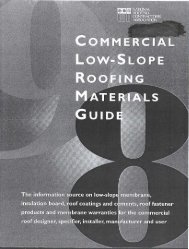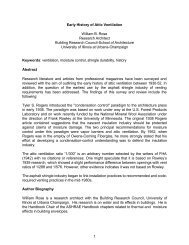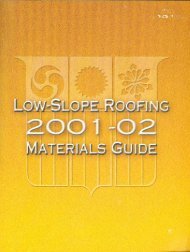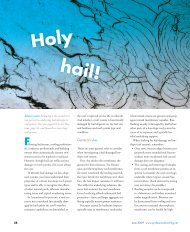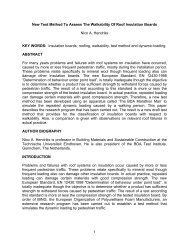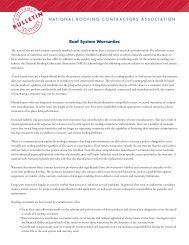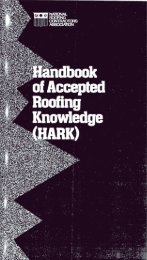1 Aging and Hail Research of PVC Membranes Frank J. Foley, Jim ...
1 Aging and Hail Research of PVC Membranes Frank J. Foley, Jim ...
1 Aging and Hail Research of PVC Membranes Frank J. Foley, Jim ...
Create successful ePaper yourself
Turn your PDF publications into a flip-book with our unique Google optimized e-Paper software.
new sample. Another example is found in Sample 1 on Table 12. The significant level<strong>of</strong> plasticizer loss for this sample (19.24 %) was not characteristic for this group. Thisdata point is also the lone, high data point on Graph 2.For these reasons, the authors consider hail simulation result to be indicative ratherthan definitive <strong>of</strong> a relationship between plasticizer loss <strong>and</strong> impact damage. Theseanomalies may be the result <strong>of</strong> excess “play” in one or more variables such as tensionor formula dispersion.6.0 CONCLUSIONS1. The older a <strong>PVC</strong> membrane, the more vulnerable the membrane to impactdamage. While this is true <strong>of</strong> all ro<strong>of</strong> membranes eroding or becoming morerigid, with exposed <strong>PVC</strong> membranes, this vulnerability is a particular concern.2. Not all <strong>PVC</strong> membranes are <strong>of</strong> the same quality. The data on plasticizer loss<strong>and</strong> impact resistance demonstrates one <strong>of</strong> the four manufacturers provides asuperior product to the U.S. low-slope ro<strong>of</strong>ing market.3. The data suggests an initial higher content <strong>of</strong> plasticizer provides a better startingpoint than a lower level. What content <strong>of</strong> monomeric plasticizer is appropriate fora <strong>PVC</strong> membrane to be sold in hail states? The data suggests less than 32%would be reason for concern depending upon the quality, type, <strong>and</strong> stability <strong>of</strong> theplasticizing agent(s). More significantly, the data suggests beginning a servicelife below 32% plasticizer content with instable plasticizers invites impactvulnerability. The data also suggests that plasticizer levels below 28% innominal 50 mil (1.2 mm) membrane would be a concern in hail-prone locations <strong>of</strong>the central United States.7.0 RECOMMENDATIONS1. On behalf <strong>of</strong> building owners in the central United States, the ro<strong>of</strong>ing industryneeds focused research into hail protection <strong>of</strong> all classes <strong>of</strong> ro<strong>of</strong>ing systemsachieving the level <strong>of</strong> expertise <strong>and</strong> consensus now taken for granted for windengineering.2. Building owners in hail-prone states should dem<strong>and</strong> suppliers, regardless <strong>of</strong>class <strong>of</strong> ro<strong>of</strong> system, provide warranty coverage against small hail, 1-1/2-inch (38mm) or less. Conventional <strong>PVC</strong> ro<strong>of</strong>s in hail-prone locations must be monitoredfor degradation. This monitoring should be a timely measurement <strong>of</strong> reducedthickness, increased durometer hardness, rising specific gravity <strong>and</strong>/or plasticizerextraction analysis. Samples <strong>and</strong> lot numbers <strong>of</strong> new membranes should be filedin contract documents, providing a “benchmark” for degradation measurement.3. <strong>PVC</strong> membrane manufacturers have a market opportunity in definingspecifications <strong>and</strong> warranties reflecting hail engineering. Thicker membranes, 60mils (1.5 mm) <strong>and</strong> greater, may provide increased impact resistance. It st<strong>and</strong>s to24




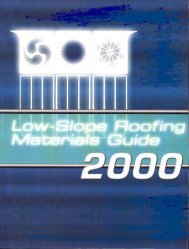
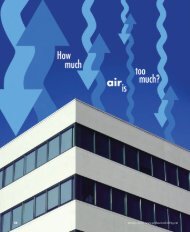
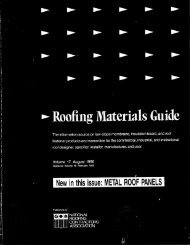
![Wm] - National Roofing Contractors Association](https://img.yumpu.com/36696816/1/190x245/wm-national-roofing-contractors-association.jpg?quality=85)

